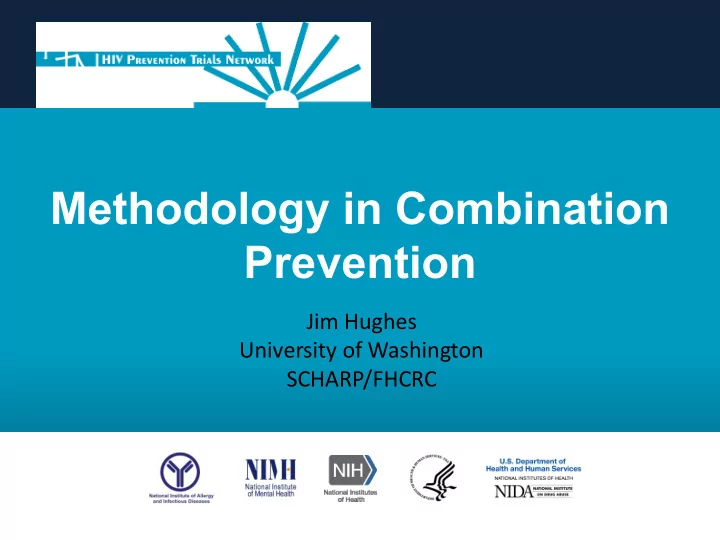

Methodology in Combination Prevention Jim Hughes University of Washington SCHARP/FHCRC
Key Scientific Issues • Effect of the package or the individual components? Are components separable? Synergy/Redundancy of components? • Short-term vs long-term effects; direct vs indirect effects • Relationship between coverage and incidence • Generalizability (across sites, populations)
Methodological Issues • Outcome measurement − Incidence − Prevalence − Process/surrogate outcomes (e.g. Coverage) − Using surveillance data • Trial Design − Individual vs cluster randomization − Two arm (all vs none) − Factorial − Implementation (e.g. stepped wedge)
Outcomes • HIV incidence − Gold standard for measuring intervention effect − Cohorts, cross-sectional incidence − Expensive, difficult to measure • HIV prevalence − Easier to measure than incidence − Lags incidence effect (except, possibly, in teens) • Process outcomes (e.g. number of MC done, proportion of population tested) – Easiest to measure – Effects often seen first on process measures – May be used for evaluating interventions where relationship with HIV incidence has previously been established – Most useful for phase 2 studies, establishing mechanisms in conjunction with HIV incidence outcomes
Outcomes • Using surveillance data (e.g. HPTN 065) − Reduces study cost − May be lower “quality” compared to research study (more missing, incomplete, errors) − (Maybe) only aggregate data available − Subject to changes in procedures and policies that are not under the control of the investigator
Level of randomization • Individual level randomization − Appropriate when the intervention is delivered to individuals and outcome measured on same individuals • Cluster level randomization − Appropriate when the intervention is delivered to groups; or when outcome is measured on different individuals from those who received intervention − Measures “real world” effect − Challenges: contamination/crossover; baseline balance; evolving SOC; testing in control communities; delay in effect
Timing of effects in CRT 1.00 HIV Incidence Rate Ratio 0.80 0.60 0.40 0 1 2 3 4 Year of Study Behavior change only Circumcision only ART only HBCT-Plus Alsallaq and Hallett
Design • Two-arm trial Assess entire package Components not separable Most components inexpensive or unlikely to have significant effect • Factorial Interest in effect of individual components or synergy/redundancy Two (or more) components expensive
Factorial Designs Intervention A A no A B A,B no A, B Intervention B no B A, no B no A, no B • Simultaneously addresses questions about marginal effects, incremental effects, combined effect • Possible for interventions to be applied at different levels i.e. A – community; B – individual
Factorial Designs • Highly efficient (multiple trials for the price of one) IF individual tx’s have independent modes of action – Independent: RR RD Tx A .8 -.05 Tx B .7 -.03 Combined .8*.7 = .56 -.05-.03=-.08 • As modes of action become more dependent, interpretation is more difficult and efficiency gains lost
Two-arm trial • Compare “All” vs “None” • Logistically easier, maybe smaller than factorial • Difficult to determine effects of individual components Variations in coverage across sites form an observational study − Detailed measurement of coverage outcomes in space and time are critical
Two-arm trial • Assessing contribution of individual components − Statistical approach - regression o Cluster-specific incidence as outcome, component coverages as predictors o Need careful consideration of temporal relationships, interactions o Minimal assumptions o Yields “narrow” predictions – Modeling approach o Incidence, component coverage, biologic and behavioral parameters as inputs (cluster, subgroup-specific) o “Fit” model using trial data to estimate component effects o Assumptions about model structure, values of other parameters may be influential o “Broader” predictions possible
Stepped Wedge Time 1 2 3 4 5 O X X X X O O X X X O O O X X O O O O X • Time of crossover is randomized; crossover is unidirectional • Need to be able to measure outcome on each unit at each time step •Multiple observations per unit; observations need to be “in sync” to control for time trends (assumed similar across clusters) • If CRT, then individuals at each time can be same (cohort) or different (cross-sectional)
Stepped Wedge • Advantages – Useful for implementation research – Fewer clusters – Addresses logistic, social, ethical concerns – Can study effect of time on treatment • Disadvantages – Long time to completion (potential for contamination, external events) – Intentional confounding of time, treatment – Delayed effects reduce power
Conclusions • Scientific questions should drive design • Multiple intervention targets, levels, indirect effects and timing of effects all pose key design challenges in combination intervention trials • Analyses of process outcomes likely will yield valuable insights, but should be calibrated to HIV incidence
Acknowledgements • Sponsored by NIAID, NIDA, NIMH under Cooperative Agreement # UM1 AI068619
Recommend
More recommend